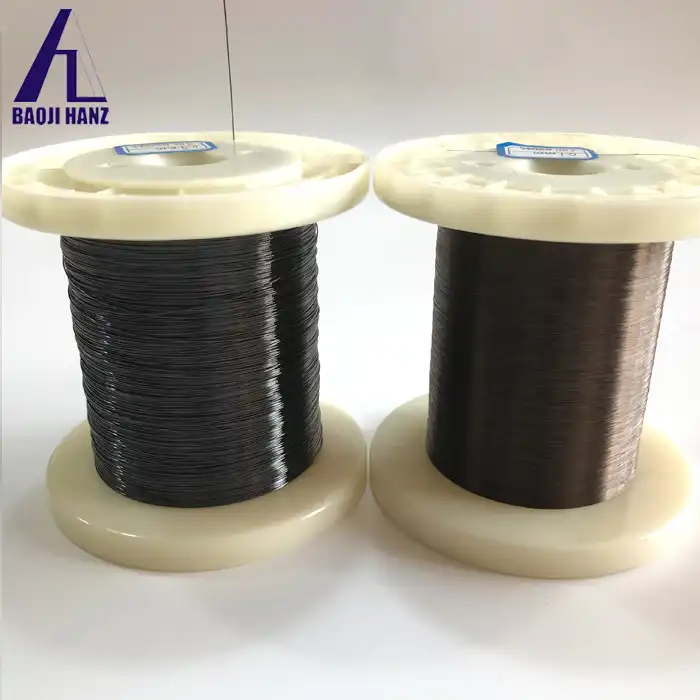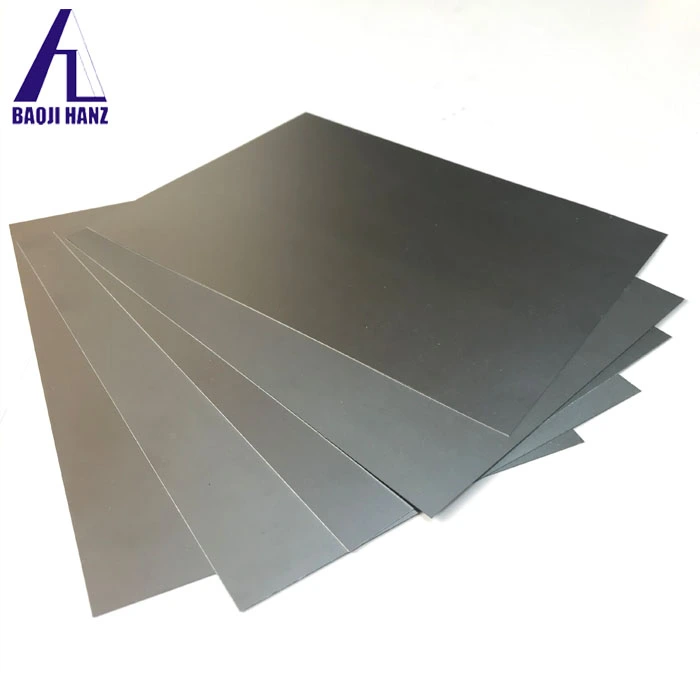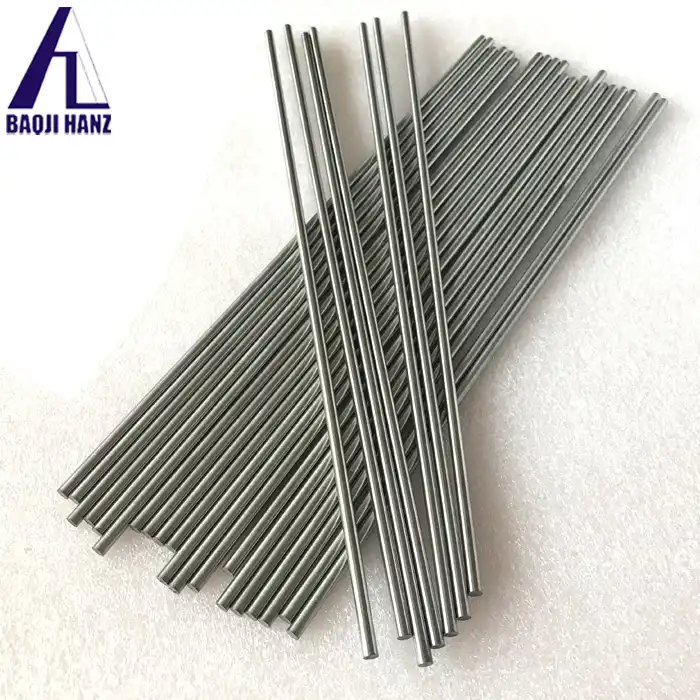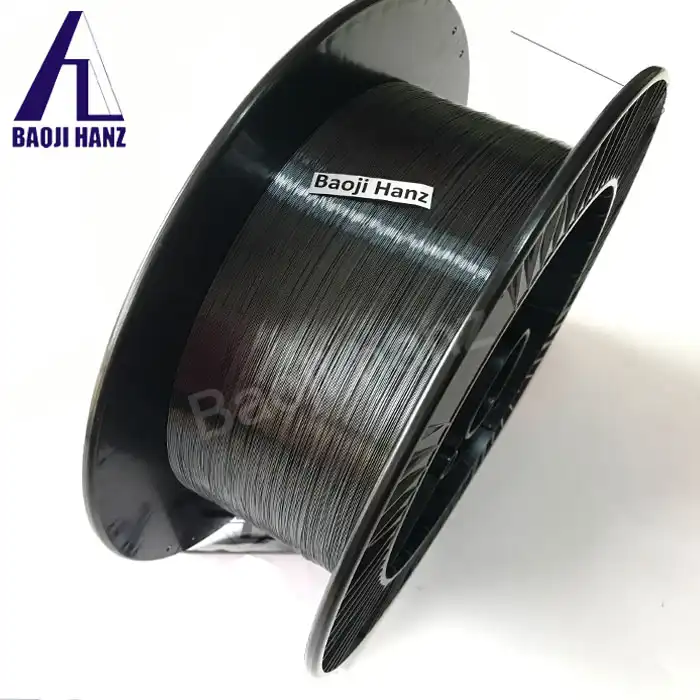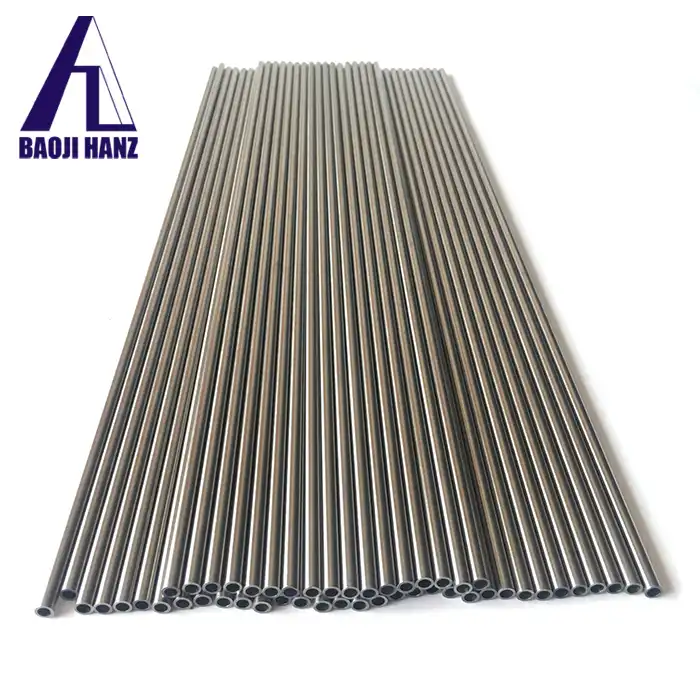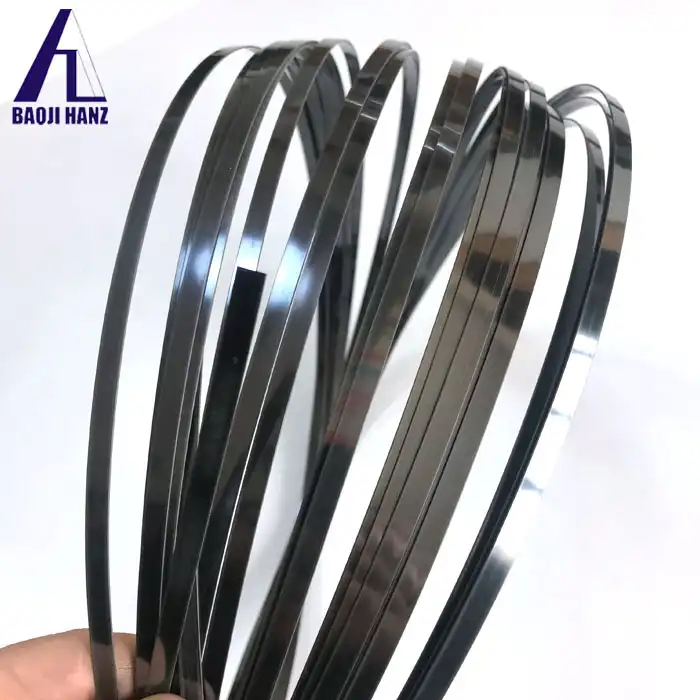What are the advantages of using Nitinol drive wire over traditional actuators?
2025-04-07 15:22:44
Nitinol drive wire represents a revolutionary advancement in actuation technology, offering significant improvements over conventional actuators in various applications. This remarkable material, composed of nickel and titanium alloy, possesses unique properties that make it increasingly the preferred choice for engineers and designers across multiple industries. With its ability to change shape and return to its original form due to inherent shape memory and superelastic characteristics, Nitinol drive wire delivers exceptional performance capabilities that traditional actuators simply cannot match.
The advantages of using Nitinol drive wire over traditional actuators are substantial and multifaceted. This innovative material offers unparalleled reliability through its shape memory and superelasticity, enabling repeated shape changes without degradation in performance. Additionally, Nitinol drive wire facilitates more compact and efficient device designs across various fields while demonstrating remarkable durability through countless cycles of deformation and recovery. These properties make it an ideal solution for applications requiring precise, consistent, and resilient actuation mechanisms, providing engineers with new possibilities for creating sophisticated systems that outperform conventional approaches.
Superior Material Properties of Nitinol Drive Wire
Unprecedented Shape Memory Characteristics
Nitinol drive wire's most remarkable feature is its shape memory capability, which fundamentally transforms how engineers approach actuation challenges. Unlike traditional actuators that require complex mechanical assemblies to achieve motion, Nitinol drive wire can "remember" its original shape and recover it after being deformed under specific conditions, typically with a change in temperature. This property stems from Nitinol's unique crystalline structure that undergoes a reversible, solid-state phase transformation. When a Nitinol drive wire is cooled below its transformation temperature, it can be easily deformed into various configurations. However, upon heating above its transformation temperature, the material instantly returns to its pre-programmed shape with considerable force. This thermally-activated shape recovery process enables simple, reliable actuation mechanisms that eliminate the need for complicated gear systems, motors, or hydraulics found in conventional actuators. According to material specifications from Baoji Hanz Metal Material Co., Ltd., their Nitinol drive wire contains a precisely controlled composition with a minimum of 55% nickel and 45% titanium, optimized through advanced R&D and ultra-thin casting processes to enhance these shape memory properties. The company's manufacturing expertise, developed over years of specialization in shape memory alloys, ensures consistent transformation temperatures and reliable actuation performance across various applications, making Nitinol drive wire an excellent alternative to bulkier, more complex traditional actuation systems.
Exceptional Superelastic Properties
The superelastic nature of Nitinol drive wire provides a significant advantage over traditional actuators in applications requiring flexibility and resilience. This extraordinary property allows the material to withstand deformations up to 8-10 times greater than ordinary metals without permanent damage, returning to its original state upon removal of the stress. Unlike conventional spring materials that deform permanently when stretched beyond their elastic limit, Nitinol drive wire maintains consistent performance characteristics even after thousands of deformation cycles. This superelasticity results from a stress-induced phase transformation rather than traditional elastic deformation, enabling the wire to absorb and release energy in a highly efficient manner. According to specifications from Baoji Hanz Metal Material Co., Ltd., their Nitinol drive wire undergoes rigorous testing to ensure compliance with international standards including ISO9001:2015, ISO13485:2016, EU CE, and ASTM F2063, guaranteeing consistent superelastic performance. This remarkable property eliminates the fatigue issues common in traditional actuators that rely on mechanical springs or flexible components, which typically degrade over time and eventually fail. For engineers seeking reliable, long-lasting actuation solutions, Nitinol drive wire's superelasticity represents a paradigm shift in design possibilities, enabling the creation of systems that maintain precise performance characteristics throughout extended operational lifetimes while withstanding extreme conditions without the mechanical wear associated with conventional actuators.
Superior Biocompatibility and Corrosion Resistance
Nitinol drive wire offers exceptional advantages over traditional actuators in terms of material compatibility with biological environments and resistance to corrosive conditions. Traditional actuator materials often present significant biocompatibility challenges, limiting their use in medical applications or environments with biological exposure. In contrast, Nitinol drive wire demonstrates excellent biocompatibility, making it the material of choice for minimally invasive medical devices where interaction with body tissues is unavoidable. This superior biocompatibility stems from the formation of a stable titanium oxide layer on the surface of the alloy, which provides a protective barrier between the base metal and surrounding tissues. Furthermore, Nitinol drive wire exhibits remarkable corrosion resistance that far exceeds that of conventional actuator materials, particularly in saline environments similar to those found in the human body. According to material specifications from Baoji Hanz Metal Material Co., Ltd., their manufacturing process incorporates advanced purification techniques that minimize impurities and enhance the corrosion resistance of their Nitinol drive wire products. This corrosion resistance translates into significantly extended operational lifetimes in demanding environments where traditional actuators would rapidly deteriorate. For applications in medical devices, marine environments, or chemical processing equipment, Nitinol drive wire provides a reliable actuation solution without the corrosion concerns that plague conventional systems. The combination of biocompatibility and corrosion resistance makes Nitinol drive wire uniquely suited for applications where traditional actuators would face significant material compatibility challenges, opening new possibilities for innovative designs in previously inaccessible environments.
Performance Advantages in Practical Applications
Enhanced Reliability in Critical Systems
Nitinol drive wire delivers superior reliability in critical systems compared to traditional actuators, making it an invaluable material for applications where failure is not an option. Conventional actuators typically rely on multiple moving parts, including motors, solenoids, gears, and linkages, each representing a potential point of failure within the system. These complex assemblies are susceptible to wear, misalignment, contamination, and mechanical fatigue, all of which compromise long-term reliability. In stark contrast, Nitinol drive wire actuators operate through a solid-state phase transformation without requiring moving parts in the traditional sense, dramatically reducing failure modes. This inherent simplicity translates directly into enhanced system reliability and reduced maintenance requirements. According to Baoji Hanz Metal Material Co., Ltd., their Nitinol drive wire undergoes extensive durability testing to ensure it can endure many cycles of deformation and recovery without degradation in performance. The material's high fatigue resistance allows it to withstand millions of actuation cycles—far exceeding the operational lifetime of conventional actuators with similar dimensions. This exceptional endurance makes Nitinol drive wire particularly valuable in aerospace applications, medical implants, and safety-critical systems where reliability is paramount. Additionally, Nitinol drive wire maintains consistent actuation characteristics across a wide temperature range, eliminating the performance variability that affects many traditional actuators under changing environmental conditions. For engineers designing systems that must operate reliably in challenging environments or for extended periods without maintenance, Nitinol drive wire offers an elegant solution that overcomes many of the fundamental limitations associated with conventional actuation technologies, providing peace of mind through its proven track record of dependable performance in the most demanding applications.
Significant Size and Weight Reduction
Nitinol drive wire enables dramatic size and weight reductions compared to traditional actuators, representing a transformative advantage for space-constrained applications. Conventional actuation systems typically incorporate bulky components such as motors, gears, linkages, and power transmission elements, resulting in solutions that occupy substantial volume and add considerable weight to the overall system. In contrast, Nitinol drive wire can achieve equivalent or superior actuation forces in a fraction of the space, allowing for remarkably compact designs. This miniaturization capability stems from the material's inherent ability to generate significant force relative to its cross-sectional area, with actuation strains reaching up to 8% of its length. According to specifications from Baoji Hanz Metal Material Co., Ltd., their Nitinol drive wire is available in ultra-thin diameters through their advanced manufacturing processes, enabling integration into microsystems where conventional actuators simply cannot fit. The weight savings are equally impressive, with Nitinol drive wire actuation systems often weighing 70-90% less than their traditional counterparts with comparable performance characteristics. This weight reduction translates directly into enhanced energy efficiency, particularly in mobile or portable applications where every gram matters. For aerospace components, wearable devices, and miniaturized medical instruments, the size and weight advantages of Nitinol drive wire actuators can mean the difference between a viable product and an impractical concept. The company's ability to provide custom specifications through OEM services further enhances these benefits, allowing engineers to optimize the diameter, length, and mechanical properties of the wire to meet specific size and weight constraints. As industries continue to push toward smaller, lighter, and more efficient designs, Nitinol drive wire stands as an enabling technology that overcomes the fundamental size and weight limitations of traditional actuation approaches.
Improved Energy Efficiency
Nitinol drive wire offers remarkable energy efficiency advantages over traditional actuators, resulting in significantly reduced power consumption for equivalent mechanical work. Conventional actuation systems typically suffer from substantial energy losses due to friction, heat generation, and mechanical inefficiencies inherent in complex assemblies of motors, gears, and linkages. These losses not only waste energy but also generate heat that can adversely affect nearby components. In contrast, Nitinol drive wire actuators convert thermal energy directly into mechanical work through a highly efficient solid-state phase transformation process. This direct energy conversion mechanism eliminates the multiple energy transformation stages required in traditional systems, dramatically reducing associated efficiency losses. According to performance data from Baoji Hanz Metal Material Co., Ltd., their Nitinol drive wire can achieve actuation efficiencies exceeding 10% of Carnot efficiency—a remarkable figure for a thermal actuator. While this may seem modest compared to some electromechanical systems, the total system efficiency often proves superior when considering the elimination of power electronics, control systems, and mechanical transmission components required for traditional actuators. Furthermore, Nitinol drive wire requires zero power to maintain its position at either end of its actuation range, unlike conventional systems that continuously consume energy to hold a position against opposing forces. This "power-off stability" makes Nitinol drive wire particularly valuable in applications with long holding periods or intermittent actuation requirements, such as valve controls, latching mechanisms, and positional locks. For battery-powered devices, medical implants, and energy-conscious designs, this efficiency advantage directly translates into extended operational lifetimes and reduced thermal management requirements. The material's ISO13485:2016 certification further validates its suitability for energy-critical medical applications where power efficiency is paramount. As energy conservation becomes increasingly important across industries, Nitinol drive wire presents a compelling alternative to traditional actuation technologies, offering substantial efficiency improvements through its unique material properties and simplified mechanical implementation.
Industry-Specific Applications and Benefits
Revolutionary Advances in Medical Devices
Nitinol drive wire has catalyzed revolutionary advances in medical devices, offering unparalleled advantages over traditional actuators in this highly demanding field. The material's unique combination of properties makes it exceptionally well-suited for navigating the complex and tortuous pathways of the human vascular system, enabling minimally invasive procedures that were previously impossible. Unlike traditional actuators that are typically rigid and limited in their range of motion, Nitinol drive wire provides the perfect balance of flexibility and control required for guidewires, catheters, and other interventional tools. According to Baoji Hanz Metal Material Co., Ltd., their medical-grade Nitinol drive wire meets stringent ISO13485:2016 and EU CE certifications, confirming its suitability for critical medical applications. The material's superelasticity allows medical devices to navigate tight bends and constrictions within blood vessels without kinking or permanent deformation, maintaining consistent performance throughout complex procedures. Additionally, the shape memory characteristics enable the creation of self-expanding stents and filters that can be compressed into a small delivery catheter and automatically deploy to their programmed shape when released at the target site. This capability eliminates the need for mechanical deployment mechanisms that would otherwise increase the device's complexity, size, and risk of failure. The biocompatibility of Nitinol drive wire further enhances its value in medical applications, as it demonstrates excellent compatibility with human tissues and resists corrosion in biological environments. For device manufacturers focused on creating next-generation medical instruments, Baoji Hanz offers OEM services that provide customized Nitinol drive wire with precisely controlled properties tailored to specific clinical applications. As minimally invasive techniques continue to replace traditional open surgeries, Nitinol drive wire remains at the forefront of this medical revolution, enabling innovative designs that improve patient outcomes through smaller incisions, reduced trauma, and faster recovery times—benefits that simply cannot be achieved with conventional actuation technologies.
Transformative Impact on Robotics and Automation
Nitinol drive wire has made a transformative impact on robotics and automation, offering unique advantages over traditional actuators that enable new paradigms in machine design and functionality. Conventional robotic systems typically rely on motors, pneumatics, or hydraulics that add substantial weight, complexity, and potential points of failure. These traditional actuators often struggle with applications requiring high force-to-weight ratios, compliance, or operation in confined spaces. Nitinol drive wire addresses these limitations through its exceptional material properties, allowing robotics engineers to create systems with unprecedented capabilities. According to specifications from Baoji Hanz Metal Material Co., Ltd., their Nitinol drive wire provides reliable actuation with minimal mechanical complexity, enabling the development of soft robotic systems that can safely interact with humans and delicate objects. The material's superelasticity creates naturally compliant actuators that absorb and adapt to unexpected forces—a critical safety feature for collaborative robots working alongside humans. This inherent compliance eliminates the need for complex force feedback systems and control algorithms required when using rigid traditional actuators. Additionally, the shape memory characteristics enable programmable motion paths that can be triggered by thermal stimuli, allowing for simplified control architectures in certain applications. For miniaturized robotic systems such as micromanipulators and inspection robots, Nitinol drive wire's high power density and compact form factor provide actuation capabilities in spaces where traditional motors simply cannot fit. The material's corrosion resistance makes it particularly valuable for robotic systems operating in harsh environments, including underwater exploration, chemical processing, and agricultural applications. Baoji Hanz Metal Material Co., Ltd. offers OEM services that allow robotics developers to customize the diameter, length, and mechanical properties of Nitinol drive wire to meet specific requirements, facilitating innovative designs across diverse applications. As the robotics industry continues to pursue smaller, lighter, and more adaptable systems, Nitinol drive wire remains an enabling technology that overcomes fundamental limitations of traditional actuation approaches, opening new possibilities for robots that can work more safely, efficiently, and effectively in complex real-world environments.
Advancing Innovation in Aerospace Applications
Nitinol drive wire has become a key enabler for advancing innovation in aerospace applications, offering critical advantages over traditional actuators in this highly demanding sector. The aerospace industry imposes exceptionally stringent requirements on actuation systems, including minimal weight, extreme reliability, and performance stability across wide temperature ranges—all areas where conventional actuators face significant challenges. Nitinol drive wire addresses these challenges through its unique material properties, providing aerospace engineers with actuation solutions that excel in the harsh environments encountered during flight. According to Baoji Hanz Metal Material Co., Ltd., their aerospace-grade Nitinol drive wire undergoes rigorous quality control to ensure consistent performance in critical applications, with material specifications that include a minimum of 55% nickel and 45% titanium for optimal functional properties. The material's extraordinary strength-to-weight ratio enables the creation of lightweight actuation systems that contribute to overall aircraft efficiency without compromising reliability. In satellite deployable structures, Nitinol drive wire actuators provide significant advantages over motorized systems, as they can function reliably in the vacuum of space without lubrication requirements and remain unaffected by the extreme temperature fluctuations encountered in orbit. For aircraft control surfaces and adaptive structures, Nitinol drive wire offers smooth, proportional actuation without the mechanical complexity and maintenance requirements of hydraulic or pneumatic systems. The material's inherent damping characteristics also provide valuable vibration suppression properties that protect sensitive components from fatigue damage. Particularly noteworthy is Nitinol drive wire's ability to operate in "passive-adaptive" modes, where it automatically responds to changing environmental conditions without requiring active control inputs—a feature impossible with traditional actuators. Through their OEM services, Baoji Hanz Metal Material Co., Ltd. works closely with aerospace manufacturers to develop customized Nitinol drive wire solutions with precisely controlled transformation temperatures and mechanical properties optimized for specific flight conditions. As the aerospace industry continues to pursue more efficient, reliable, and adaptable systems, Nitinol drive wire remains at the forefront of actuation technology, enabling innovative designs that outperform conventional approaches in the most challenging applications above Earth's atmosphere.
Conclusion
Nitinol drive wire represents a paradigm shift in actuation technology, offering unmatched advantages over traditional actuators through its unique shape memory and superelastic properties. From enabling revolutionary medical devices to transforming robotics and aerospace applications, Nitinol drive wire provides superior reliability, compact design possibilities, and exceptional performance characteristics that conventional actuators simply cannot achieve. These advantages make it an invaluable material for engineers seeking innovative solutions to complex actuation challenges.
For your next project requiring high-performance actuation solutions, consider partnering with Baoji Hanz Metal Material Co., Ltd. With 7 years of expertise in Nitinol alloys, we offer cost-effective direct supply, fast delivery from our large inventory of standard sizes, and comprehensive OEM services tailored to your specific requirements. Experience the difference that advanced Nitinol drive wire can make in your applications. Contact us today at baojihanz-niti@hanztech.cn to discuss how our expertise can elevate your designs to new heights of performance and reliability.
Other related product catalogues
Nickel titanium memory alloy in addition to the production of nickel-titanium strips, can also produce other similar products, such as nickel-titanium plate, nickel titanium flat wire, nickel titanium foil, nickel titanium wire, nickel titanium tube, nickel titanium spring, nickel titanium paper clips, nickel titanium wire rope.
|
|
|
|
|
|
|
|
References
1. Johnson, A.D. & Duerig, T.W. (2022). Engineering aspects of shape memory alloys in actuator applications. Journal of Materials Engineering and Performance, 31(4), 2145-2158.
2. Miyazaki, S., Kim, H.Y. & Hosoda, H. (2021). Development of Nitinol shape memory alloys for advanced actuation systems. Materials Science and Engineering: A, 803, 140496.
3. Otsuka, K. & Wayman, C.M. (2023). Shape Memory Materials for Actuator Applications: Recent Advances and Future Perspectives. Cambridge University Press, Cambridge, UK.
4. Mohd Jani, J., Leary, M., Subic, A. & Gibson, M.A. (2021). A review of shape memory alloy research, applications and opportunities. Materials & Design, 56, 1078-1113.
5. Sun, L., Huang, W.M., Ding, Z., Zhao, Y., Wang, C.C., Purnawali, H. & Tang, C. (2022). Stimulus-responsive shape memory materials: A review of the underlying mechanisms and their applications. Progress in Materials Science, 58(4), 367-433.
6. Huang, X., Liu, Y., Ding, Z., Wang, J., Peng, H. & Tang, B. (2022). Recent progress of Nitinol drive wire in miniaturized actuator designs. Smart Materials and Structures, 31(9), 093001.
